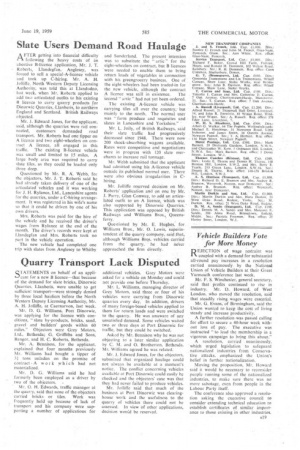Slate Users Demand Road Haulage
Page 21

If you've noticed an error in this article please click here to report it so we can fix it.
AFTER getting into financial difficulty following the heavy costs of an abortive B-licence application, Mr. J. T. Roberts, Llandegfan,, Anglesey, was forced to sell a special-A-licence vehicle and took up C-hiring. Mr. A. H. Jolliffe, North Western Deputy Licensing Authority, was told this at Llandudno, last week, when Mr. Roberts applied to add two articulated outfits to his existing E licence to carry quarry products for Dinorwic Quarries, Llanberis, to northern England and Scotland. British Railways objected.
Mr. J. Edward Jones, for the applicant, said, althatigh the quarries were fail connected, customers demanded road transport. Mr. Roberts had one tipper on A licence and two eight-wheelers on contract A licence, all engaged in this traffic. The existing B-licence vehicle was small and limited to 15 miles, A large body area was required to carry slate tiles, as they could be loaded only three deep.
Questioned by Mr. R. A. Webb, for the objectors, Mr. J. T. Roberts said he had already taken delivery of one of the articulated vehicles and it was working for J. H. Rylance, Ltd., Lancashire agents for the quarries, under a C-hiring arrangement. It was registered in his wife's name so that it could be driven by one of his own drivers.
Mrs. Roberts was paid for the hire of the vehicle and he received the driver's wages from Rylance at the end of the month. The drivers records were kept at Llandegfan and Mrs. Roberts took no part in the vehicle operation.
The new vehicle had completed one trip with slates from Anglesey to Whitby and Sunderland. The present intention was to substitute the " artic " for the eight-wheelers on contract, but B licences were needed to enable them to bring return loads of vegetables in connection with his greengrocery business. One of the eight-wheelers had been traded-in for the new vehicle, although the contract A licence was still in existence. The iecond " artic " had not yet been ardered, The existing A-licence vehicle was carrying tiles all over the country, but mainly to the north. The normal user was " farm produce and requisites and slates in Lancashire and Yorkshire." ' Mr. L. Jolly, of British Railways, said their slate traffic had progressively decreased since 1948. There were now 200 shock-absorbing wagons available. Rates were competitive and negotiations were in progress with 120 slate merchants to increase rail tonnage.
Mr. Webb submitted that the applicant had admitted using his A-licence vehicle outside its published normal user. There were also obvious irregularities in Chiring.
Mr. Joni& reserved decision on Mr. Roberts' application and on one by Mr. J. Parry. Glan Conway, to add an articulated outfit to an A licence, which was also supported by Dinorwic ,Quarries. This application was opposed by British Railways and Williams Bros.,, Queensferry.
Questioned by Mr. E. Hughes, for Williams Eros., Mr. 0. Lewis, superintendent Of the quarry company, said that, although Williams Bros. vehicles carried from the quarry, he had ne‘ler approached the firm directly.




































































